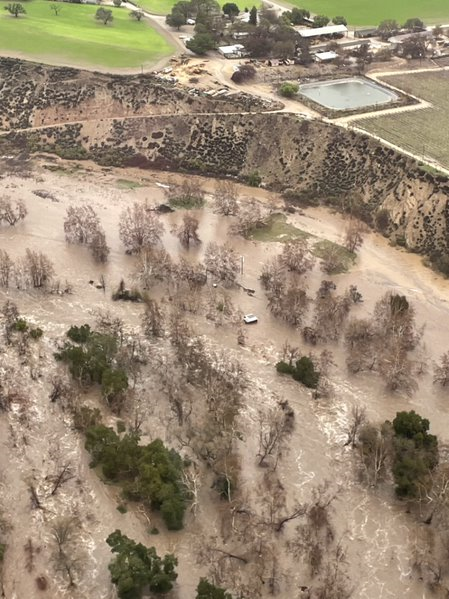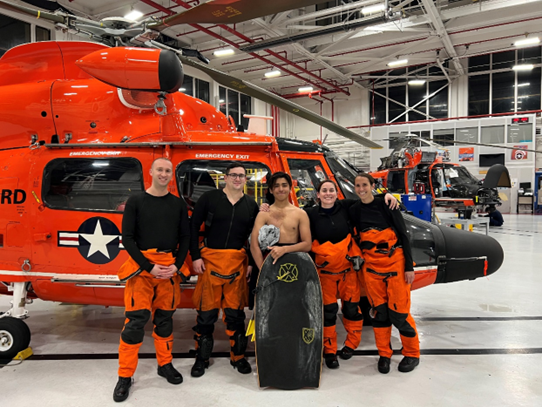March 1, 2023 —

An MH-65E crewmember from Coast Guard Air Station San Francisco surveys flooding during a flight over the Morro Bay, California, area in early January 2023. The team, Cmdr. Jeremy Courtade, Cmdr. Min Kim, Petty Officer Second Class John Sandling and Chief Petty Officer Andrew Stover, rescued an 86-year-old woman who was experiencing a cardiac event after being stranded on a flooded road. U.S. Coast Guard photo.
Record amounts of rain caused by a series of atmospheric rivers drenched California in early January; the National Oceanic and Atmospheric Administration reported that more than 32 trillion gallons of water fell during the weather event. Throughout the flooding, mudslides and levee failures that resulted, Coast Guard Air Station San Francisco worked diligently to ensure the safety of residents and first responders and the preservation of the environment.
The San Francisco crew was aided in its task by the enhanced capabilities of the upgraded MH-65E helicopter, which they have been flying for just over six months. Upgrades to the MH-65E include the Common Avionics Architecture System (CAAS) that replaces legacy analog instruments, upgraded flight planning and flight director modes, and a digital Radar Sensor System (RSS) that integrates with CAAS.
The new radar system proved especially useful during the challenging conditions caused by the extreme weather. “When flying in low-visibility conditions with gusty winds during California’s winter storms, the radar modes worked well,” Lt. Daniel Whitaker noted. “The most helpful thing I found was the radar; using Ground Map Mode (GMAP2) and the weather modes made my job a lot easier as the safety pilot as we were able to identify heavier precipitation more easily from a further distance.” GMAP2 is one mode of the radar and provides terrain-mapping information.
Cmdr. Jeremy Courtade, Air Station San Francisco’s aviation engineering officer, shared a story where the upgrades helped in saving a life. An MH-65E crew was traveling in poor visibility conditions in the area of Morro Bay, California, when they were called on to rescue an 86-year-old woman suffering from hypothermia who was stranded on a flooded road after initially being assisted by rescuers from the California Department of Forestry and Fire Protection (CAL FIRE). “Her car was nearly submerged, and they had her in what appeared to be an abandoned truck,” Courtade said. “She was on her way to a pacemaker appointment when she got trapped. When we got to her, she was in AFib (atrial fibrillation).” He noted, “The hoist camera was awesome … moving maps was great.”
During the winter storms Jan. 3-19, the Air Station San Francisco crews flew 39.5 flight hours assisting around the state, including the areas around San Jose, Watsonville, Coyote Creek, Pajaro River, Salinas River and Morro Bay, the area from the Salinas Valley to the Arroyo Seco River and the Carmel River between the Pacific Ocean and Carmel Valley Village.
Coast Guard aircraft from Sector San Diego, Sector Humboldt Bay, Sector North Bend and Air Station Astoria joined Air Station San Francisco in the response effort. Five lives were saved by Coast Guard air crews, who flew 37 missions during the January weather events. Those missions included 95.6 hours in support of the weather event, 48.1 hours flown conducting flood assessments and 19.6 hours conducting search and rescue. The Coast Guard coordinated efforts with numerous federal, state and local agencies, including the California Governor’s Office of Emergency Services, the Federal Emergency Management Agency, CAL FIRE Air and Ground, California National Guard 129th Rescue Wing and eight county sheriff’s offices.
In addition to all the distress calls attributed to the heavy rainfall, Air Station San Francisco faced its usual level of offshore search and rescue cases during January. In one rescue in the vicinity of Rockaway Beach, the aircrew encountered low cloud ceilings, rain, haze and gusty winds. Lt. Cmdr. Eric Schwartz explained how the MH-65E upgrades helped with the mission by noting the specific flight director mode that was used to depart from over the water environment. “After departing the hover at Rockaway Beach, I used the go-around button to establish barometric altitude, speed and heading to help with our right turn facing offshore with no visuals. Having spent the previous 5 to 10 minutes trying to maintain a steady hover while battling turbulent winds and low illumination, I was happy to have some relief at the controls.”
Air Station San Francisco fully transitioned to the MH-65E in October 2022.

An overflight view of the Arroya Seco River in California. An MH-65E, CGNR 6538, crewed by Lt. Cmdr. Eric Schwartz, Lt. Jaclyn McElligott, Petty Officer Second Class Isaac Gutierrez and Petty Officer Third Class Tate Lewis rescued two adults and one dog when their house was surrounded by the flooding in January. U.S. Coast Guard Photo by Lt. Cmdr. Eric Schwartz.

The Air Station San Francisco crew of CGNR 6538 rescued a boogie boarder near Rockaway Beach, California, in January. Those who took part in the rescue (from left): Lt. Cmdr. Eric Schwartz, Petty Officer Second Class Kevin Lai, Lt. Jaclyn McElligott and Petty Officer Second Class Lawren Escobosa. U.S. Coast Guard photo.
For more information: MH-65 Short Range Recovery Helicopter Program page